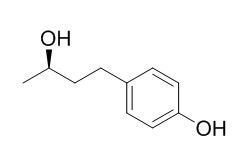Rhododendrol
Rhododendrol is an inhibitor of melanin synthesis developed for lightening/whitening cosmetics, it can competitively inhibit mushroom tyrosinase and serve as a good substrate, while it also shows cytotoxicity against cultured human melanocytes at high concentrations sufficient for inhibiting tyrosinase. (+)-Rhododendrol and epi-rhododendrin have anti-inflammatory effect, they can suppress the NO production by activated macrophages in vivo.
Inquire / Order:
manager@chemfaces.com
Technical Inquiries:
service@chemfaces.com
Tel:
+86-27-84237783
Fax:
+86-27-84254680
Address:
1 Building, No. 83, CheCheng Rd., Wuhan Economic and Technological Development Zone, Wuhan, Hubei 430056, PRC
Providing storage is as stated on the product vial and the vial is kept tightly sealed, the product can be stored for up to
24 months(2-8C).
Wherever possible, you should prepare and use solutions on the same day. However, if you need to make up stock solutions in advance, we recommend that you store the solution as aliquots in tightly sealed vials at -20C. Generally, these will be useable for up to two weeks. Before use, and prior to opening the vial we recommend that you allow your product to equilibrate to room temperature for at least 1 hour.
Need more advice on solubility, usage and handling? Please email to: service@chemfaces.com
The packaging of the product may have turned upside down during transportation, resulting in the natural compounds adhering to the neck or cap of the vial. take the vial out of its packaging and gently shake to let the compounds fall to the bottom of the vial. for liquid products, centrifuge at 200-500 RPM to gather the liquid at the bottom of the vial. try to avoid loss or contamination during handling.
Fitoterapia.2024, 175:105958.
J Plant Biochem.Biotech.2024, 33:353-366.
Environ Toxicol.2023, 23929.
Preprints2017, 2017120176
Int J Vet Sci Med.2024, 12(1):134-147.
Pak J Pharm Sci.2019, 32(6)
Applied Biological Chemistry2022, 65(77).
Herbal Formula Science2024, 32(2):155-179.
Sci Rep.2019, 9(1):4646
Universitat Stuttgart2022, opus-12200.
Related and Featured Products
J Dermatol Sci. 2014 Oct;76(1):16-24.
Depigmentation caused by application of the active brightening material, rhododendrol, is related to tyrosinase activity at a certain threshold.[Pubmed:
25082450]
Unexpected depigmentation of the skin characterized with the diverse symptoms was reported in some subjects who used a tyrosinase-competitive inhibiting quasi-drug, Rhododendrol. To investigate the mechanism underlying the depigmentation caused by Rhododendrol-containing cosmetics, this study was performed.
METHODS AND RESULTS:
The mechanism above was examined using more than dozen of melanocytes derived from donors of different ethnic backgrounds. The RNAi technology was utilized to confirm the effect of tyrosinase to induce the cytotoxicity of Rhododendrol and liquid chromatography-tandem mass spectrometry was introduced to detect Rhododendrol and its metabolites in the presence of tyrosinase. Melanocyte damage was related to tyrosinase activity at a certain threshold. Treatment with a tyrosinase-specific siRNA was shown to dramatically rescue the Rhododendrol-induced melanocyte impairment. Hydroxyl-Rhododendrol was detected only in melanocytes with higher tyrosinase activity. When an equivalent amount of hydroxyl-Rhododendrol was administered, cell viability was almost equally suppressed even in melanocytes with lower tyrosinase activity.
CONCLUSIONS:
The generation of a tyrosinase-catalyzed hydroxyl-metabolite is one of the causes for the diminishment of the melanocyte viability by Rhododendrol.
Pigment Cell Melanoma Res. 2014 Sep;27(5):754-63.
Rhododendrol, a depigmentation-inducing phenolic compound, exerts melanocyte cytotoxicity via a tyrosinase-dependent mechanism.[Pubmed:
24890809 ]
METHODS AND RESULTS:
Rhododendrol, an inhibitor of melanin synthesis developed for lightening/whitening cosmetics, was recently reported to induce a depigmentary disorder principally at the sites of repeated chemical contact. Rhododendrol competitively inhibited mushroom tyrosinase and served as a good substrate, while it also showed cytotoxicity against cultured human melanocytes at high concentrations sufficient for inhibiting tyrosinase. The cytotoxicity was abolished by phenylthiourea, a chelator of the copper ions at the active site, and by specific knockdown of tyrosinase with siRNA. Hence, the cytotoxicity appeared to be triggered by the enzymatic conversion of Rhododendrol to active product(s). No reactive oxygen species were detected in the treated melanocytes, but up-regulation of the CCAAT-enhancer-binding protein homologous protein gene responsible for apoptosis and/or autophagy and caspase-3 activation were found to be tyrosinase dependent.
CONCLUSIONS:
These results suggest that a tyrosinase-dependent accumulation of ER stress and/or activation of the apoptotic pathway may contribute to the melanocyte cytotoxicity.
Planta Med. 1998 Oct;64(7):598-602.
(+)-Rhododendrol and epi-rhododendrin suppress the NO production by activated macrophages in vivo.[Pubmed:
9810263]
METHODS AND RESULTS:
In this study, we investigated the effect of (+)-Rhododendrol (1) and epi-rhododendrin (2) isolated from Acer nikoense Maxim. (Aceraceae) on nitric oxide (NO) production in mouse peritoneal macrophages elicited by bacillus Calmette-Guérin and in vitro stimulated by lipopolysaccharide. The NO production was not affected by an oral administration of methanol extract at a dose of 100 mg/kg/day. However, the AcOEt soluble fraction significantly reduced the NO production. (+)-Rhododendrol (1) isolated as an active substance from the AcOEt fraction suppressed the NO production. epi-Rhododendrin (2), the glucoside of (+)-Rhododendrol (1) isolated from the n-BuOH fraction, also suppressed the NO production.
CONCLUSIONS:
As NO is one of the critical mediators in inflammation, these results suggest that (+)-Rhododendrol (1) and epi-rhododendrin (2) contribute in part to the anti-inflammatory effect of A. nikoense.
Bioorg Med Chem Lett. 2014 Jan 1;24(1):122-5.
Chemical synthesis and tyrosinase inhibitory activity of rhododendrol glycosides.[Pubmed:
24332496]
METHODS AND RESULTS:
The concise synthesis of Rhododendrol glycosides 3-8, which are novel derivatives of (+)-epirhododendrin (1) and (-)-rhododendrin (2), has been achieved in six steps from benzaldehyde 9. The key reactions include aldol condensation and trichloroacetimidate glycosylation. From biological studies, it has been determined that synthetic derivatives of 1 and 2 possess potent tyrosinase inhibitory activity. Particularly, the inhibitory activity of cellobioside 8 (IC50=1.51μM) is six times higher than that of kojic acid.
CONCLUSIONS:
The R-epimers (4, 6, and 8) possessed more potent activity than the corresponding S-epimers (3, 5, and 7), indicating that tyrosinase inhibitory activity is significantly governed by stereochemistry of Rhododendrol glycosides.



